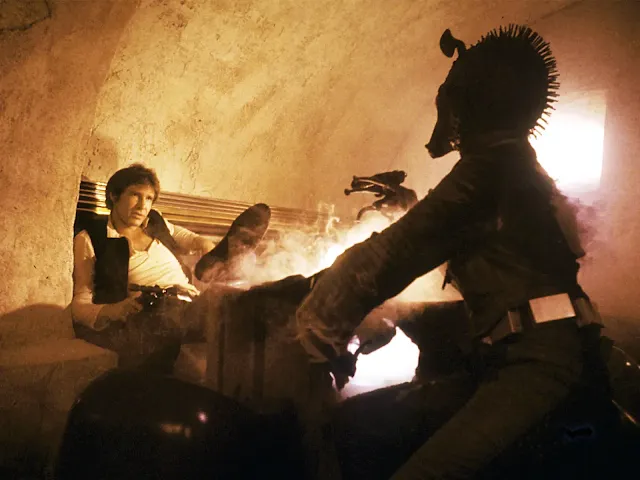The heart of the "Han shot first" debate is firmly rooted in the climactic confrontation within the Mos Eisley Cantina. In the raw and unaltered 1977 release, Han Solo's actions are unmistakably clear: he shoots Greedo with a swift precision that leaves no room for retaliation. However, as the years progressed, the scene underwent modifications orchestrated by George Lucas himself. These alterations shifted the sequence of shots, giving the impression that Greedo had fired first, and Han's response was a reaction of self-defense.
This seemingly minor change led to a considerable divide among fans, who passionately disputed whether these edits aligned with the core essence of Han Solo's character.
To fathom the significance of the original scene, one must delve into the creative intentions of George Lucas during the inception of the 1977 film. At that juncture, Han Solo's character was envisaged as a morally ambiguous rogue, a charismatic smuggler with a penchant for self-preservation. The decision to have Han shoot first was a strategic narrative choice by Lucas, vividly portraying Han's street-smart savvy and his readiness to navigate the treacherous underworld he inhabited.
This particular act of unapologetic self-interest not only laid the foundation for Han's character arc but also illuminated his capacity for change over the course of the trilogy.
A meticulous examination of Han Solo's character trajectory across the original trilogy highlights the integral role of the "Han shot first" moment. Introduced as a self-serving opportunist motivated primarily by personal gain, Han's actions in the cantina scene marked the inception of a profound transformation.
The "Han shot first" scene wasn't merely an isolated incident; it was a cornerstone that propelled Han's evolution from a morally ambiguous renegade to a selfless leader within the Rebel Alliance. His readiness to take action, even if ruthless, foreshadowed his journey towards embracing a higher purpose beyond his own interests.
The resonance of the "Han shot first" controversy extends beyond the confines of the Star Wars universe, emerging as a cultural phenomenon in its own right. It serves as a vivid illustration of the fervor that accompanies a beloved franchise, where each detail is scrutinized and revered by an impassioned fanbase.
The resonance of the "Han shot first" controversy extends beyond the confines of the Star Wars universe, emerging as a cultural phenomenon in its own right. It serves as a vivid illustration of the fervor that accompanies a beloved franchise, where each detail is scrutinized and revered by an impassioned fanbase.
This debate transcends the boundaries of a single scene, encapsulating broader discussions about artistic autonomy, the ethical considerations surrounding alterations, and the profound influence of fan sentiment on the sanctity of source material.
The enduring legacy of the "Han shot first" controversy extends far beyond the realm of Star Wars, acting as a testament to the intricate interplay between creators and their devotees. It underscores the undeniable power of fandom and its potential to shape the course of a narrative. The debate encourages contemplation on the nuanced relationship between artists and their work, provoking introspection about how artistic choices impact the collective emotional connection of a fanbase.
In light of subsequent anniversary releases and the alterations that accompanied them, a comprehensive evaluation is imperative. These changes, aimed at harmonizing narrative continuity, inevitably invite deliberation on their alignment with the underlying themes and character arcs of the Star Wars saga. Assessing the impact of these modifications demands a balanced analysis, weighing their implications on Han Solo's character progression, the emotional resonance of the scene, and the overarching narrative
In the tapestry of the Star Wars saga, the "Han shot first" controversy transcends a mere debate and evolves into a multifaceted exploration of fandom, artistic interpretation, and character development. The original "Han shot first" scene reverberates as a pivotal moment, echoing throughout the trilogy and beyond. It remains a testament to the intricate dance between creators and their audience, demonstrating the lasting imprint that dedicated fans leave on the legacy of a beloved franchise.
The enduring legacy of the "Han shot first" controversy extends far beyond the realm of Star Wars, acting as a testament to the intricate interplay between creators and their devotees. It underscores the undeniable power of fandom and its potential to shape the course of a narrative. The debate encourages contemplation on the nuanced relationship between artists and their work, provoking introspection about how artistic choices impact the collective emotional connection of a fanbase.
In light of subsequent anniversary releases and the alterations that accompanied them, a comprehensive evaluation is imperative. These changes, aimed at harmonizing narrative continuity, inevitably invite deliberation on their alignment with the underlying themes and character arcs of the Star Wars saga. Assessing the impact of these modifications demands a balanced analysis, weighing their implications on Han Solo's character progression, the emotional resonance of the scene, and the overarching narrative
In the tapestry of the Star Wars saga, the "Han shot first" controversy transcends a mere debate and evolves into a multifaceted exploration of fandom, artistic interpretation, and character development. The original "Han shot first" scene reverberates as a pivotal moment, echoing throughout the trilogy and beyond. It remains a testament to the intricate dance between creators and their audience, demonstrating the lasting imprint that dedicated fans leave on the legacy of a beloved franchise.














